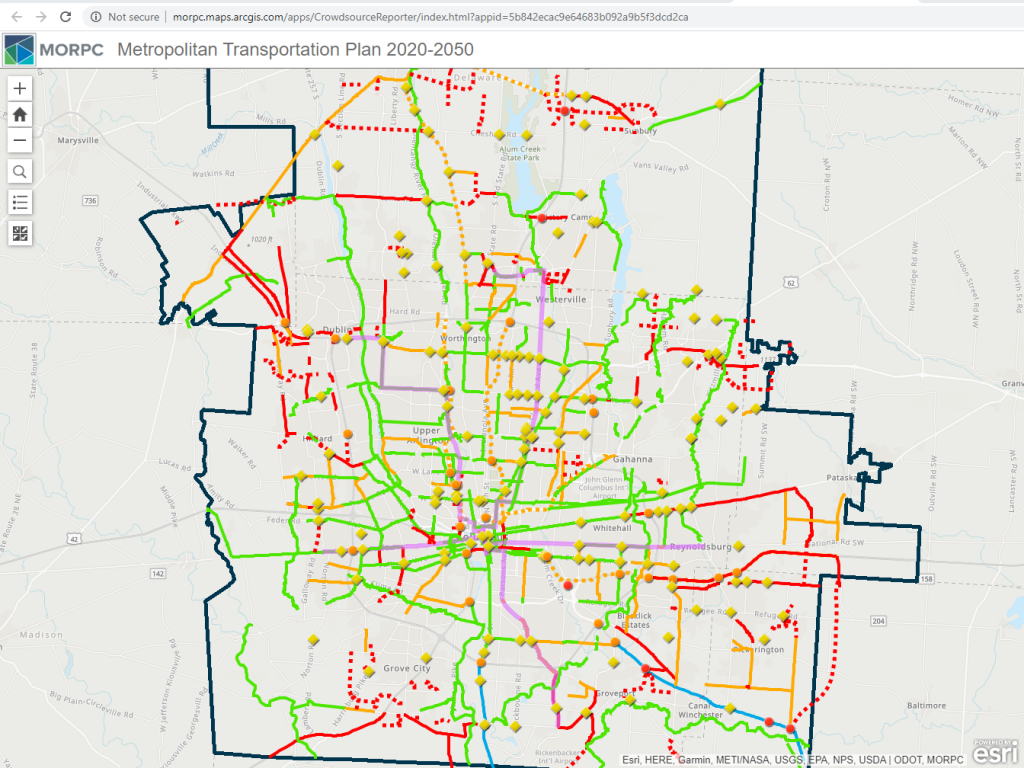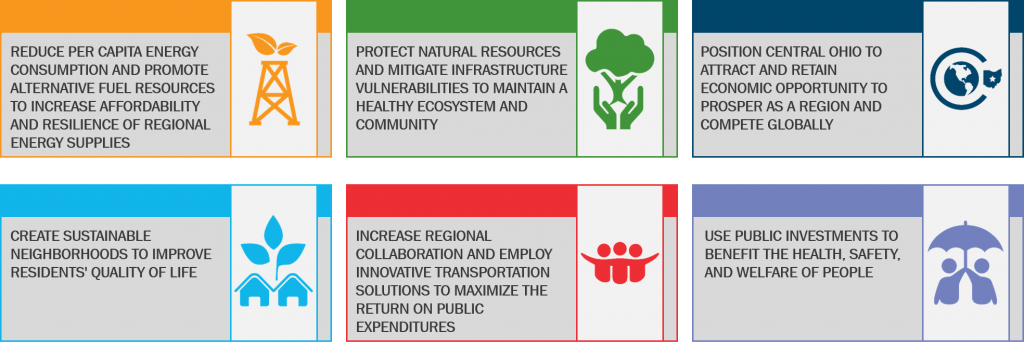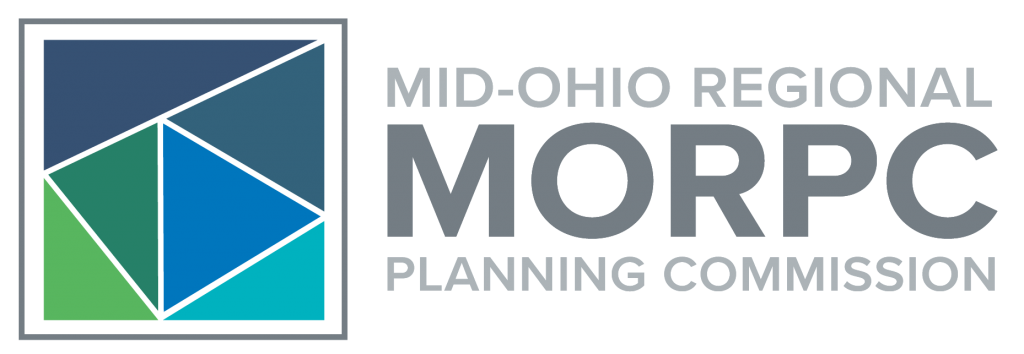2020-2050 MTP Amended on September 8, 2022
To support the development of the proposed Intel site and the resulting regional growth, state and local agencies have committed to advancing area roadway network improvements. The 2020-2050 Metropolitan Transportation Plan was amended by Resolution T-9-22 to incorporate the corridor information resulting from the planned state and local Intel-related investments. More information can be found here. Due to the significance of the changes to the MTP, it is federally required to do an analysis to confirm the projects included in the amended MTP do not lead to violations in the air quality standard or delay obtaining the standard. This is called a conformity determination. The incorporation of the projects in the amendment into the conformity analysis has been completed. A summary of this analysis is available here. The MTP documents have been updated to reflect the amendment.More on the MTP
The plan is based on six regional goals. Objectives, performance measures, strategies, and projects have been identified for tracking progress in achieving the goals. The following is a breakdown of the MTP by chapter:2020-2050 Metropolitan Transportation Plan / Table of Contents
Chapter 1 – Plan Purpose & Development
Chapter 3 – The Transportation System
Chapter 6 – System Development
Chapter 7 – Project Evaluation & Fiscal Constraint
Chapter 8 – Summary of Strategies & Projects
Chapter 9 – Plan Implementation & Monitoring
Appendix B – Air Quality Conformity
Appendix C – Environmental Justice Technical Analysis
Appendix D – Environmental Mitigation
A public open house was held at MORPC on Feb. 26, 2020. The presentation from the open house can be viewed here.

Projects Webmap
We have identified transportation needs and projects located within MORPC’s transportation planning area. Various project types are included
Regional Goals
The regional goals will guide the development of the MTP and give direction to investments in the regional transportation system. These goals represent six broad visions, which will each be measured by objectives, measures, and targets. The goals were adopted by resolution of the MORPC Transportation Policy Committee, with approval of both the Community Advisory Committee and Transportation Advisory Committees on September 13, 2018, following a public comment period.
Through transportation:

The progress of achieving each goal will be measured by several objectives. Two to five objectives have been identified for each goal. Objectives were chosen to measure certain aspects of each goal that can be impacted through transportation or the transportation system, and are based on data availability and measurability. For each objective, the existing condition, or benchmark, is documented and used to establish a short- and long-term target (years 2025 and 2050). The region’s progress toward reaching these targets will be reported on annually.
Objectives & Performance Measures
| OBJECTIVE: Reduce the percentage of commuters driving alone, and increase the percentage of commuters riding transit, bicycle, or walking | |||
| Rationale | 2020 MTP Benchmark | 2025 Target | 2050 Target |
| Reducing single occupancy auto commutes and increasing commuters using alternative transportation modes will reduce per capita fuel and energy consumption. |
|
|
|
| OBJECTIVE: Reduce vehicle miles traveled (VMT) per capita | |||
| Rationale | 2020 MTP Benchmark | 2025 Target | 2050 Target |
| Reducing vehicle miles traveled per person for any trip purpose will reduce per capita fuel and energy consumption. |
|
|
|
| OBJECTIVE: Increase the percentage of vehicles using alternative fuels | |||
| Rationale | 2020 MTP Benchmark | 2025 Target | 2050 Target |
| Increased use of alternative fuel vehicles is a direct measurement of alternative fuel usage. |
|
|
|
| OBJECTIVE: Increase the number of alternative fuel stations** | |||
| Rationale | 2020 MTP Benchmark | 2025 Target | 2050 Target |
| Alternative fuel infrastructure supports the adoption of alternative fuel vehicles. |
|
|
|
| OBJECTIVE: Reduce emissions from mobile sources to continuously meet EPA air quality standards for each criteria pollutant | |||
| Rationale | 2020 MTP Benchmark | 2025 Target | 2050 Target |
| Clean air an essential natural resource and is a key indicator of a healthy community. |
|
|
|
| OBJECTIVE: Decrease the locations of freeway and expressway facilities that are at risk for flooding | |||
| Rationale | 2020 MTP Benchmark | 2025 Target | 2050 Target |
| Flooding prohibits safe travel and is a result of vulnerabilities during extreme weather events. |
|
|
|
![]()
| OBJECTIVE: Increase the average number of jobs reachable within 20 minutes and within 40 minutes via automobile and via transit | |||
| Rationale | 2020 MTP Benchmark | 2025 Target | 2050 Target |
| Access to jobs within reasonable travel time is important for the vitality of a region’s economy. |
2018 Travel Demand Model |
|
|
| OBJECTIVE: Minimize the percentage of total vehicle miles traveled under congested conditions | |||
| Rationale | 2020 MTP Benchmark | 2025 Target | 2050 Target |
| Efficient mobility of people and freight is an important element of a vibrant economy. |
2018 Travel Demand Model on functionally classified Collectors and above, 2017 RITIS |
|
|
| OBJECTIVE: Minimize the amount of extra, or buffer, travel time necessary when planning expected trip travel time. | |||
| Rationale | 2020 MTP Benchmark | 2025 Target | 2050 Target |
| Freight carriers, commuters and businesses need reliable and consistent travel times to ensure the on-time delivery of goods and most efficiently use their time. |
Calculated from Jan-Dec 2017 INRIX data, arterials and above
2018 ODOT |
|
|
| OBJECTIVE: Encourage and support MORPC member communities to adopt complete streets policies or policies that contain those elements | |||
| Rationale | 2020 MTP Benchmark | 2025 Target | 2050 Target |
| Complete streets allow for transportation choices, which enhance quality of life. |
|
|
|
| OBJECTIVE: Increase the amount of bicycle and pedestrian infrastructure | |||
| Rationale | 2020 MTP Benchmark | 2025 Target | 2050 Target |
| Sustainable neighborhoods provide adequate bicycle and pedestrian infrastructure to provide viable transportation options. |
|
|
|
| OBJECTIVE: Target infrastructure development to serve a higher number or people and jobs | |||
| Rationale | 2020 MTP Benchmark* | 2025 Target* | 2050 Target* |
| Sustainable neighborhoods provide adequate bicycle and pedestrian infrastructure to provide viable transportation options. |
|
|
|
| OBJECTIVE: Increase the number of bike/pedestrian miles traveled on COG trails annually | |||
| Rationale | 2020 MTP Benchmark | 2025 Target | 2050 Target |
| Central Ohio Greenways (COG) are an integral component connecting sustainable neighborhoods around the region. |
|
|
|
| OBJECTIVE: Increase the percentage of funding from non-public sources on transportation projects on functionally classified Principal Arterials and above | |||
| Rationale | 2020 MTP Benchmark | 2025 Target | 2050 Target |
| Creative funding partnerships are a result of regional collaboration and seeking out innovative solutions. |
|
|
|
| OBJECTIVE: Increase the number of projects utilizing innovative initiatives on functionally classified Principal Arterials and above | |||
| Rationale | 2020 MTP Benchmark | 2025 Target | 2050 Target |
| Encourage initiatives that advance innovation and partnership to deliver and build projects efficiently. |
|
|
|
| OBJECTIVE: Increase the percentage of functionally classified Minor Arterials and above facilities employing coordinated Intelligent Transportation System (ITS) technologies, and increase the percentage of all facilities that incorporate digital infrastructure. | |||
| Rationale | 2020 MTP Benchmark | 2025 Target | 2050 Target |
| ITS provides for maximization of capacity on existing facilities and real-time response to incidents and security issues. |
|
|
|
| OBJECTIVE: Increase the number of transit vehicles and facilities with surveillance capabilities and increase the miles of functionally classified Principal Arterials and above with video surveillance | |||
| Rationale | 2020 MTP Benchmark | 2025 Target | 2050 Target |
| Surveillance capabilities allow for real-time response to incidents and security issues. |
|
|
|
| OBJECTIVE: Increase the percentage of funding from non-public sources on transportation projects on functionally classified Principal Arterials and above | |||
| Rationale | 2020 MTP Benchmark | 2025 Target | 2050 Target |
| Creative funding partnerships are a result of regional collaboration and seeking out innovative solutions. |
|
|
|
| OBJECTIVE: Increase the number of projects utilizing innovative initiatives on functionally classified Principal Arterials and above | |||
| Rationale | 2020 MTP Benchmark | 2025 Target | 2050 Target |
| Encourage initiatives that advance innovation and partnership to deliver and build projects efficiently. |
|
|
|
| OBJECTIVE: Increase the percentage of functionally classified Minor Arterials and above facilities employing coordinated Intelligent Transportation System (ITS) technologies, and increase the percentage of all facilities that incorporate digital infrastructure. | |||
| Rationale | 2020 MTP Benchmark | 2025 Target | 2050 Target |
| ITS provides for maximization of capacity on existing facilities and real-time response to incidents and security issues. |
|
|
|
| OBJECTIVE: Increase the number of transit vehicles and facilities with surveillance capabilities and increase the miles of functionally classified Principal Arterials and above with video surveillance | |||
| Rationale | 2020 MTP Benchmark | 2025 Target | 2050 Target |
| Surveillance capabilities allow for real-time response to incidents and security issues. |
|
|
|
| OBJECTIVE: Encourage and support MORPC member communities to adopt Smart Streets policies or policies that contain those elements | |||
| Rationale | 2020 MTP Benchmark | 2025 Target | 2050 Target |
| Smart streets policies are a tool communities can use to integrate technology into transportation projects. |
|
|
|
| OBJECTIVE: Minimize the difference in trip travel time for disadvantaged populations relative to the regional trip travel time | |||
| Rationale | 2020 MTP Benchmark | 2025 Target | 2050 Target |
| The transportation system should equally serve all of the region’s population. |
|
|
|
| OBJECTIVE: Maintain infrastructure in a state of good repair by minimizing the percentage of bridges and pavements in poor condition and maintaining transit fleet of a useful life | |||
| Rationale | 2020 MTP Benchmark | 2025 Target | 2050 Target |
| Maintenance and enhancement of existing infrastructure ensures the maximum lifespan and safe use of public investments |
|
|
|
| OBJECTIVE: Reduce the number of fatalities and serious injuries from crashes | |||
| Rationale | 2020 MTP Benchmark | 2025 Target | 2050 Target |
| Crash reduction is a direct measurement of safety. |
|
|
|
The objectives and performance measures can be viewed in a printable format here.
Recent Community Presentations
- Licking County Area Transportation Study 3/10/20
- Village of Urbancrest 3/10/20
- City of Whitehall 3/10/20
- City of Reynoldsburg 3/9/20
- Franklin Township 3/5/20
- Village of Harrisburg 3/3/20
- City of Grove City 3/2/20
- City of Grandview Heights 3/2/20
- City of Columbus 2/25/20
- South Side Area Commission 2/25/20
- City of Pickerington Finance Committee 2/19/20
- University Area Commission 12/19/20
- Westland Area Commission 2/19/20
- Jerome Township 2/18/20
- Village of Powell 2/18/20
- Village of Marble Cliff 2/17/20
- Near East Area Commission 2/13/20
- Bloom Township 2/12/20
- City of Upper Arlington 2/11/20
- City of Groveport 2/10/20
- Village of Obetz 2/10/20
- Village of Minerva Park 2/10/20
- Far South Columbus Area Commission 2/6/20
- Northeast Area Commission 2/6/20
- COTA Board Strategic Operations & Planning Committee 2/5/20
- BIA Builders & Developers Council 2/5/20
- Columbus Region Logistics Council 1/31/20
- Delaware County Commissioners 1/30/20
- City of Bexley 1/28/20
- Far West Area Commission 1/28/20
- City of Hilliard 1/27/20
- Village of Galena 1/27/20
- City of Canal Winchester 1/21/20
- City of Dublin 1/21/20
- City of New Albany 1/21/20
- Licking County Commissioners 1/16/20
- West Scioto Area Commission 1/16/20
- COTA Mobility Advisory Board 1/15/20
- Delaware County Transit Board 1/15/20
- Southwest Area Commission 1/15/20
- Franklinton Area Commission 1/14/20
- Milo-Grogan Area Commission 1/14/20
- City of Delaware 1/13/20
- City of Worthington 1/13/20
- Far East Area Commission 1/7/20
- Northland Community Council 1/7/20
- City of Westerville 1/7/20
- Village of Ashley 1/7/20
- Valleyview 1/6/20
- Delaware County Regional Planning Commission 12/19/19
- Village of Sunbury 12/18/19
- Village of Riverlea 12/16/19
- Liberty Township 12/16/19
- Village of Brice 12/12/19
- Franklin County Planning 12/11/19
- Greater Southeast Area Commission 12/10/19
- Village of Lockbourne 12/9/19
- Village of Ostrander 12/9/19
- Village of Shawnee Hills 12/9/19
- North Central Area Commission 12/5/19
- Clintonville Area Commission 12/5/19
- Northwest Civic Association 12/4/19
- Violet Township 12/4/19
- 5th by Northwest Area Commission 12/3/19
- Fairfield County 12/3/19
- Greater Hilltop Area Commission 12/3/19
- Union County 12/3/19
Presentation slides were also provided to the following:
- City of Gahanna 3/16/20
- City of Pataskala 3/16/20
- South Linden Area Commission 3/17/20
- Livingston Area Commission 3/19/20
- North Linden Area Commission 3/19/20
- Village of Lithopolis 3/24/20
- Gahanna Kiwanis 4/6/20
(The COVID-19 stay-at-home order prevented in-person presentations to these groups.)

